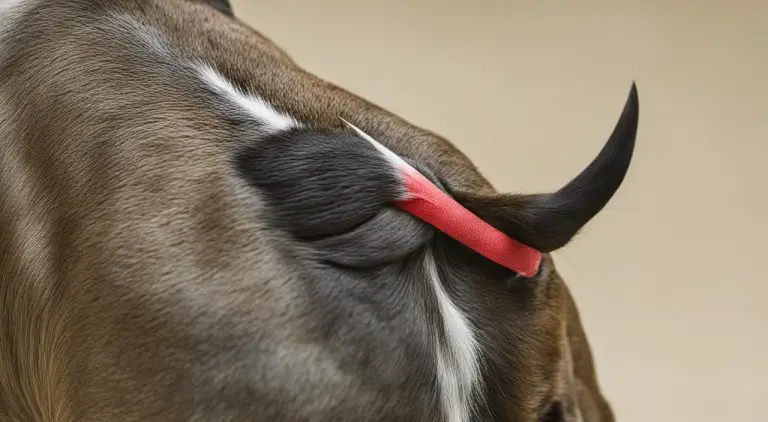French Bulldog Tail Problems: Causes and Solutions
French Bulldogs are a popular breed of dog, known for their friendly personalities and unique physical characteristics. However, one aspect of their anatomy that can cause health issues is their tail.
French Bulldogs have a short, screw-shaped tail that is prone to certain problems, including infections and spinal deformities.
Tail pocket infections are a common issue for French Bulldogs. The tail pocket is a small crevice between the base of the tail and the body, which can collect dirt, droppings, and bacteria. This can lead to infections that cause swelling, redness, and discomfort for the dog. In addition to infections, French Bulldogs can also experience spinal deformities that cause pressure on the spinal cord and make walking difficult.

Anatomy of a French Bulldog Tail
French Bulldogs are known for their distinctively short, stumpy tails. In general, their tails are straight or slightly curved, and they are not very long. Here are some key features of a French Bulldog tail:
- Length: Typically, a French Bulldog’s tail is only a few inches long. It is not long enough to curl over the dog’s back.
- Shape: The tail is straight or slightly curved, and it tapers to a point.
- Texture: The tail is covered in short, smooth fur that is similar to the fur on the rest of the dog’s body.
- Color: The tail is usually the same color as the rest of the dog’s coat.
Despite their short length, French Bulldog tails can still be prone to certain health issues. For example, some French Bulldogs have tails that are tightly curled or twisted. This can be a sign of a spinal deformity called hemivertebrae, which can cause pain and even paralysis. Another issue that can affect French Bulldog tails is tail pocket infections.
This occurs when the dog’s tail is not properly cleaned, and bacteria or yeast builds up in the folds of skin. This can be painful and uncomfortable for the dog, and it can lead to serious health problems if left untreated.
Overall, while French Bulldog tails may seem simple, it is important to be aware of the potential health issues that can arise.
Regular cleaning and grooming can help prevent infections, and any unusual changes in the tail’s shape or texture should be evaluated by a veterinarian.
Related: Check If you can Remove a French Bulldog Tail
Common Tail Problems in French Bulldogs
French Bulldogs are prone to several tail problems that can cause discomfort and pain. Here are some of the most common tail problems in French Bulldogs:
- Tail Pocket Infections: French Bulldogs have a short, screw tail that can create a pocket around the anal area. This pocket can easily become infected, leading to symptoms such as swelling, pus formation, severe itchiness, and a foul odor. It’s important to keep the tail pocket clean and dry to prevent infection.
- Hemivertebrae: Hemivertebrae is a spinal deformity that can cause a twisted or kinked tail. This condition can be painful and may require surgery to correct.
- Sunburn: French Bulldogs have a short, thin coat that offers little protection from the sun. This can lead to sunburn on the tail, which can be painful and may require treatment with a topical cream.
If you notice any signs of tail problems in your French Bulldog, such as swelling, bleeding, or discharge, it’s important to seek veterinary care right away. Early intervention can prevent the problem from becoming more serious and causing your dog unnecessary pain and discomfort.
In addition to seeking veterinary care, there are steps you can take to prevent tail problems in your French Bulldog. Keeping the tail pocket clean and dry, providing shade and protection from the sun, and avoiding activities that could cause trauma to the tail can all help keep your dog’s tail healthy and pain-free.
Symptoms of French Bulldog Tail Problems
Pain and Discomfort
Pain and discomfort are the most common symptoms of tail problems in French Bulldogs. Your Frenchie may whimper, yelp, or flinch when you touch their tail or rear end. They may also show signs of restlessness, irritability.
Swelling and Redness
Swelling and redness in the tail area are also common symptoms of French Bulldog tail problems. The tail may appear inflamed and tender to the touch. In some cases, there may also be an open wound or a discharge.
Difficulty in Wagging Tail
French Bulldogs with tail problems may have difficulty wagging their tail or may not be able to move it at all. This can affect their ability to communicate with other dogs and humans, as well as their balance and coordination.
Loss of Bowel Control
In severe cases, French Bulldog tail problems can lead to loss of bowel control. This is because the tail muscles are responsible for controlling the anal sphincter, which helps to hold in feces and urine. When the tail muscles are damaged, this can cause incontinence.
Diagnosis and Treatment of French Bulldog Tail Problems
If you suspect that your French Bulldog is suffering from a tail problem, you should take them to the vet for a diagnosis. The vet will examine your Frenchie’s tail and may perform imaging tests, such as x-rays or MRI, to determine the underlying cause of the problem.
Veterinary Examination and Diagnosis
Depending on the cause of the tail problem, the vet may prescribe medications, such as antibiotics or painkillers, or recommend surgery. In some cases, physical therapy and rehabilitation may also be necessary to help your Frenchie regain mobility and strength in their tail.
Medications and Surgery
Medications may be prescribed to manage pain and inflammation, as well as to treat any underlying infections. Surgery may be necessary in cases of severe injury or deformity, such as with hemivertebrae or a fractured tail.
Physical Therapy and Rehabilitation
Physical therapy and rehabilitation can be helpful in cases where the tail problem is caused by a muscular injury or weakness. This can involve exercises to strengthen the tail muscles and improve range of motion, as well as massage and other therapeutic techniques.
Prevention of French Bulldog Tail Problems
While not all tail problems in French Bulldogs can be prevented, there are steps you can take to minimize the risk of your Frenchie developing a tail problem.
Regular Veterinary Checkups
Regular veterinary checkups are essential for detecting and treating health problems early, including tail problems. Your vet can monitor your Frenchie’s tail health and provide advice on proper care and preventive measures.
Proper Tail Care
Proper tail care can also help prevent tail problems in French Bulldogs. This includes keeping the tail area clean and dry, avoiding tight collars or harnesses that can put pressure on the tail, and trimming any excess hair around the tail area.
Exercise and Weight Management
Exercise and weight management are also important for preventing tail problems in French Bulldogs. Regular exercise can help keep your Frenchie’s tail muscles strong and healthy, while maintaining a healthy weight can reduce the risk of injury or strain.
Avoiding Tail Trauma
Finally, avoiding tail trauma is crucial for preventing tail problems in French Bulldogs. This means protecting your Frenchie from accidents and injuries, such as by keeping them away from busy roads or areas with sharp objects, and supervising them during playtime to prevent roughhousing.
Conclusion
In conclusion, French Bulldog tail problems can be caused by a range of factors, from congenital conditions to injuries and infections. Early detection and treatment are key to preventing serious complications and ensuring your Frenchie’s tail health. By following proper care and preventive measures, you can help keep your French Bulldog’s tail healthy and happy.
FAQs
Can French Bulldogs be born without a tail?
Yes, French Bulldogs can be born without a tail or with a very short tail. This is a genetic trait that is often seen in some breeds, including Frenchies. While taillessness is not a health concern, it can affect a dog’s balance and coordination, and may also cause problems with communication and signaling.
How can I tell if my French Bulldog has a tail problem?
Some common signs of tail problems in French Bulldogs include pain, swelling, redness, difficulty in wagging the tail, and loss of bowel control. If you notice any of these symptoms in your Frenchie, it’s important to take them to the vet for a diagnosis.
Is surgery always necessary for French Bulldog tail problems?
Surgery is not always necessary for French Bulldog tail problems. The course of treatment depends on the underlying cause of the problem. In some cases, medication, physical therapy, or other non-surgical treatments may be sufficient to manage the condition. However, in cases of severe injury or deformity, surgery may be necessary.
What can I do to prevent tail problems in my French Bulldog?
To prevent tail problems in French Bulldogs, it’s important to take proper care of their tails. This includes keeping the tail area clean and dry, avoiding tight collars or harnesses that can put pressure on the tail, and trimming any excess hair around the tail area. Regular exercise and weight management can also help keep your Frenchie’s tail muscles strong and healthy.
Can tail problems affect my French Bulldog’s bowel control?
Yes, in some cases, tail problems in French Bulldogs can lead to loss of bowel control. This is because the tail muscles are responsible for controlling the anal sphincter, which helps to hold in feces and urine. When the tail muscles are damaged, this can cause incontinence. It’s important to take your Frenchie to the vet for diagnosis and treatment if you notice any signs of tail problems.


![How Much Are French Bulldogs At Petland [Clarified]](https://onlyfrenchbulldog.com/wp-content/uploads/2024/06/how-much-are-french-bulldogs-at-petland-clarified_3117-768x550.jpg)
![Can French Bulldogs Be Service Dogs [Resolved]](https://onlyfrenchbulldog.com/wp-content/uploads/2024/06/can-french-bulldogs-be-service-dogs-resolved_3127-768x550.jpg)
![What To Give A Frenchie With Diarrhea [Elaborated]](https://onlyfrenchbulldog.com/wp-content/uploads/2024/06/what-to-give-a-frenchie-with-diarrhea-elaborated_3135-768x550.jpg)

